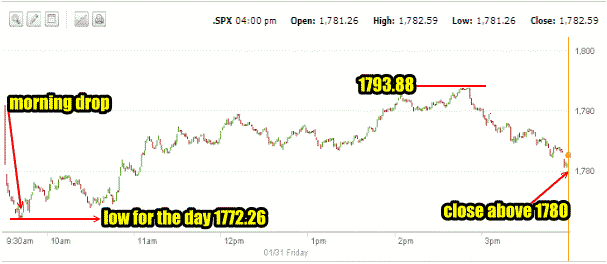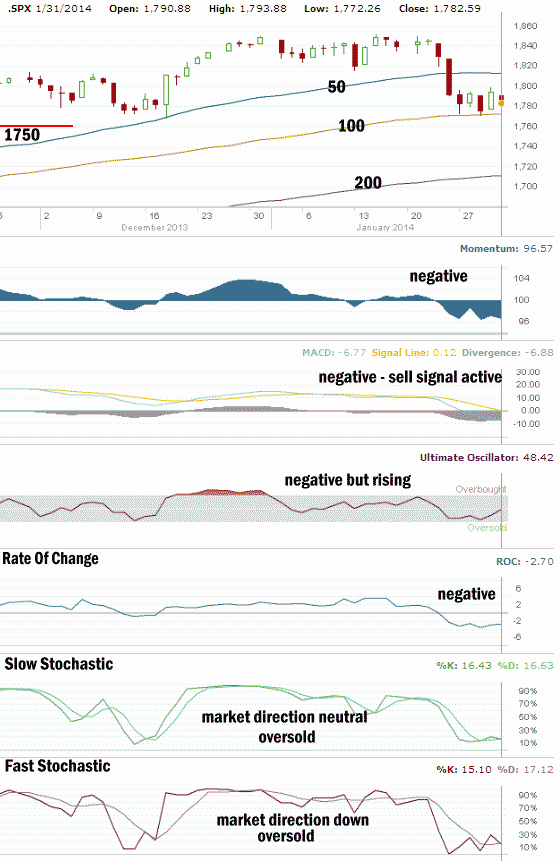The market direction for Friday was for stocks to shift sideways and move lower. Instead stocks plunged at the outset and then recovered. They recovered far more than I expected. I was surprised at the strength of the move back up in the afternoon especially in the SPX which with a little more push could actually have returned to neutral or possibly even squeaked out a positive reading. The Dow also was pushed back hard as many investors obviously felt the plunge was overdone. I know I felt the plunge was overdone but I also felt the push back was also overdone and I made another trade in the market direction portfolio. Members can review the trades from Jan 31 here.
A lot of analysts on Friday commented that overall, January felt more like just profit taking was going on rather than any serious concerns. Almost all pointed out that they felt the market internals were still strong. A lot of analysts felt that investors were looking for a reason to take profits from the substantial gains made in 2013 and that’s what happened in January. I was surprised at how many analysts felt that the historic data over January setting the tone for the market direction was nothing to be worried about.
Market Direction S&P 500 Daily Chart for Jan 31 2014
The 1 minute chart for Friday’s action on the SPX is below. You can see the dramatic plunge in the morning. This took stocks down to 1772.26 by the open. Here is where I sold shares of DXD I had previously bought. Shortly after I wrote that I would not be adding more even if the market fell lower. I saw an interview with Art Cashin during the day on Friday in which he commented that if 1770 broke he was expected serious selling to enter the market. Cashin has been around for 50 years and is highly respected. But a second low failed to break lower than the first opening low and the market climbed back. As the market climbed higher I bought more DXD shares as I was surprised at the extent of the push back by stocks. The high of 1793.88 shortly before 3:00 PM couldn’t hold primarily as it was Friday and few investors want to hold over the weekend. Investors sold the market back down another 12 points to have it close just above 1780. A dramatic day on Friday to be sure.

Advance Declines For Jan 31 2014
New lows are continuing to dominate as 142 stocks made new lows on Friday and just 59 made new highs. 60% of stock were declining while 36% were advancing. This actually was an improvement for advancing issues.
Market Direction Closings For Jan 31 2014
The S&P closed at 1782.59 down 11.60. The Dow closed at 15,698.85 down 149.76. The NASDAQ closed at 4103.88 down just 19.25.
Meanwhile the IWM ETF fell 0.74% to close at $112.16.
All the indexes were well off their lows for the day as obviously a lot of investors felt that Friday’s plunge was an opportunity to buy stocks.
Market Direction Technical Indicators At The Close of Jan 31 2014
Let’s review the market direction technical indicators at the close of Jan 31 2014 on the S&P 500 and view the market direction outlook for Feb 3 2014.

The most important support line in the S&P 500 is at 1750. That support line is holding the market direction up at present and that has not changed. Even with Friday’s big drop the S&P did not break through the 100 day moving average. If you look at the Friday you can see that the market actually closed above the 100 day.
For Momentum I am using the 10 period. Momentum has been the best indicator over the past two months, replacing MACD as the most accurate indicator. Momentum remains strongly negative.
For MACD Histogram I am using the Fast Points set at 13, Slow Points at 26 and Smoothing at 9. MACD (Moving Averages Convergence / Divergence) issued a sell signal on Jan 8 2014 which was confirmed on Jan 9. MACD refused to turn positive since Jan 8. MACD remained strongly negative on Friday.
The Ultimate Oscillator settings are Period 1 is 5, Period 2 is 10, Period 3 is 15, Factor 1 is 4, Factor 2 is 2 and Factor 3 is 1. These are not the default settings but are the settings I use with the S&P 500 chart set for 1 to 3 months.
The Ultimate Oscillator is negative but you can see that it is moving rapidly higher which could signal a recovery to start the week.
Rate Of Change is set for a 21 period. The rate of change is still negative but it is not falling. Instead it is moving sideways which indicates that investors in general are not selling heavily on these big down turns.
For the Slow Stochastic I use the K period of 14 and D period of 3. The Slow Stochastic is signaling that the market direction is neutral.
For the Fast Stochastic I use the K period of 20 and D period of 5. These are not default settings but settings I set for the 1 to 3 month S&P 500 chart when it is set for daily. The Fast Stochastic is indicating that the market will move lower on Monday.
Market Direction Outlook And Strategy for Feb 3 2014
The heavy days of selling are having their toll on the technical indicators. Momentum and MACD are particularly negative. Worries about everything from deflation in Europe and emerging market currencies and debt continue to weigh heavily on investors. Most actually have no real understanding of what these issues are all about but as long as they dominate the news, investors remain cautious and many are nervous. In this kind of environment I am still invested but I am taking smaller positions and keeping larger amounts of capital on the sidelines to take advantage of opportunities.
While the number of stocks hitting new 52 week lows continues to climb, the percentage of stocks falling is dropping off. While this may seem odd considering the number of new lows, many of the new lows are the same stocks each day falling to another new low. Friday though saw 36% of stocks advancing. This means this is a bull market correction.
The market direction technical indicators are mixed again. While all are negative, there are signs of encouragement from many of the technical indicators. The Ultimate Oscillator in particular is pointing to strength building again. The slow stochastic is sitting neutral which is a good sign for the market as well. The Rate Of Change is definitely negative but remains flat refusing to fall lower.
It is primarily the other three indicators, momentum, MACD and Fast Stochastic that are the most negative. Therefore the outlook remains negative with a bias lower. Investors may push the market back to the 100 day EMA once more and that will tell us if the market will correct further. We could see another 1 or 2 percent loss in stocks but many stocks are trading below their 200 day moving averages and are very oversold. Investors are looking for opportunities and many are finding them in stocks that are deeply oversold.
We should though remain careful here as a rebound could happen. Part of the reason to remain cautiously optimistic is the number of stocks that are not selling lower. Stocks like Caterpillar, Facebook, Microsoft, DuPont, Visa, Priceline and others are holding their own and are still hanging on as investors continue to sell the market lower. In a market that is breaking apart all stocks move lower. It becomes rare when a stock does not follow the trend. That is still not happening which is why this pullback remains a shallow correction at this stage in the bull market. It is for this reason that I am still not selling calls against the stocks I follow.
Despite all the news about Europe, China, currencies, deflation, there is one strong key to the present correction and that has been the strengthening dollar. The rise of the dollar has impacted other world currencies and markets. If the dollar begins to fall, then look for stocks to stabilize and move higher.
Market Direction Internal Links
Profiting From Understanding Market Direction (Articles Index)
Understanding Short-Term Signals
Market Direction Portfolio Trades (Members)
Market Direction External Links
Market Direction IWM ETF Russell 2000 Fund Info
Market Direction SPY ETF 500 Fund Info
